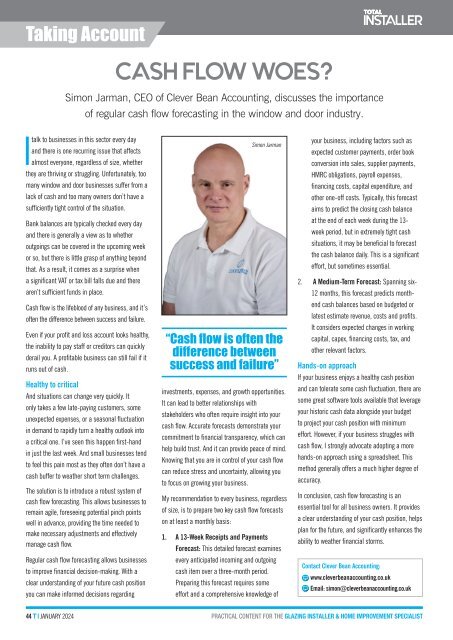January 2024
You also want an ePaper? Increase the reach of your titles
YUMPU automatically turns print PDFs into web optimized ePapers that Google loves.
Contract Taking Account Talk<br />
CASH FLOW WOES?<br />
Simon Jarman, CEO of Clever Bean Accounting, discusses the importance<br />
of regular cash flow forecasting in the window and door industry.<br />
Italk to businesses in this sector every day<br />
and there is one recurring issue that affects<br />
almost everyone, regardless of size, whether<br />
they are thriving or struggling. Unfortunately, too<br />
many window and door businesses suffer from a<br />
lack of cash and too many owners don’t have a<br />
sufficiently tight control of the situation.<br />
Bank balances are typically checked every day<br />
and there is generally a view as to whether<br />
outgoings can be covered in the upcoming week<br />
or so, but there is little grasp of anything beyond<br />
that. As a result, it comes as a surprise when<br />
a significant VAT or tax bill falls due and there<br />
aren’t sufficient funds in place.<br />
Cash flow is the lifeblood of any business, and it’s<br />
often the difference between success and failure.<br />
Even if your profit and loss account looks healthy,<br />
the inability to pay staff or creditors can quickly<br />
derail you. A profitable business can still fail if it<br />
runs out of cash.<br />
Healthy to critical<br />
And situations can change very quickly. It<br />
only takes a few late-paying customers, some<br />
unexpected expenses, or a seasonal fluctuation<br />
in demand to rapidly turn a healthy outlook into<br />
a critical one. I’ve seen this happen first-hand<br />
in just the last week. And small businesses tend<br />
to feel this pain most as they often don’t have a<br />
cash buffer to weather short term challenges.<br />
The solution is to introduce a robust system of<br />
cash flow forecasting. This allows businesses to<br />
remain agile, foreseeing potential pinch points<br />
well in advance, providing the time needed to<br />
make necessary adjustments and effectively<br />
manage cash flow.<br />
Regular cash flow forecasting allows businesses<br />
to improve financial decision-making. With a<br />
clear understanding of your future cash position<br />
you can make informed decisions regarding<br />
investments, expenses, and growth opportunities.<br />
It can lead to better relationships with<br />
stakeholders who often require insight into your<br />
cash flow. Accurate forecasts demonstrate your<br />
commitment to financial transparency, which can<br />
help build trust. And it can provide peace of mind.<br />
Knowing that you are in control of your cash flow<br />
can reduce stress and uncertainty, allowing you<br />
to focus on growing your business.<br />
My recommendation to every business, regardless<br />
of size, is to prepare two key cash flow forecasts<br />
on at least a monthly basis:<br />
Simon Jarman<br />
“Cash flow is often the<br />
difference between<br />
success and failure”<br />
1. A 13-Week Receipts and Payments<br />
Forecast: This detailed forecast examines<br />
every anticipated incoming and outgoing<br />
cash item over a three-month period.<br />
Preparing this forecast requires some<br />
effort and a comprehensive knowledge of<br />
your business, including factors such as<br />
expected customer payments, order book<br />
conversion into sales, supplier payments,<br />
HMRC obligations, payroll expenses,<br />
financing costs, capital expenditure, and<br />
other one-off costs. Typically, this forecast<br />
aims to predict the closing cash balance<br />
at the end of each week during the 13-<br />
week period, but in extremely tight cash<br />
situations, it may be beneficial to forecast<br />
the cash balance daily. This is a significant<br />
effort, but sometimes essential.<br />
2. A Medium-Term Forecast: Spanning six-<br />
12 months, this forecast predicts monthend<br />
cash balances based on budgeted or<br />
latest estimate revenue, costs and profits.<br />
It considers expected changes in working<br />
capital, capex, financing costs, tax, and<br />
other relevant factors.<br />
Hands-on approach<br />
If your business enjoys a healthy cash position<br />
and can tolerate some cash fluctuation, there are<br />
some great software tools available that leverage<br />
your historic cash data alongside your budget<br />
to project your cash position with minimum<br />
effort. However, if your business struggles with<br />
cash flow, I strongly advocate adopting a more<br />
hands-on approach using a spreadsheet. This<br />
method generally offers a much higher degree of<br />
accuracy.<br />
In conclusion, cash flow forecasting is an<br />
essential tool for all business owners. It provides<br />
a clear understanding of your cash position, helps<br />
plan for the future, and significantly enhances the<br />
ability to weather financial storms.<br />
Contact Clever Bean Accounting:<br />
www.cleverbeanaccounting.co.uk<br />
Email: simon@cleverbeanaccounting.co.uk<br />
44 T I JANUARY <strong>2024</strong> PRACTICAL CONTENT FOR THE GLAZING INSTALLER & HOME IMPROVEMENT SPECIALIST
















